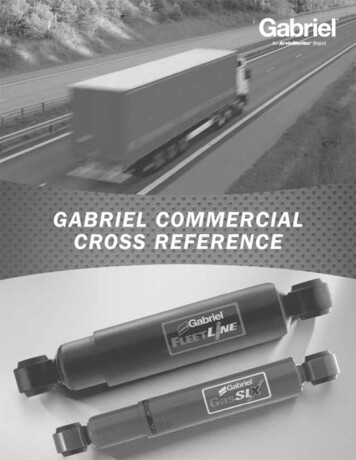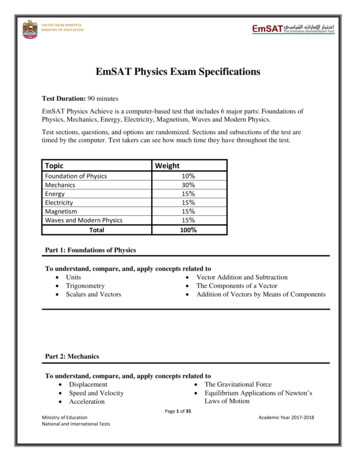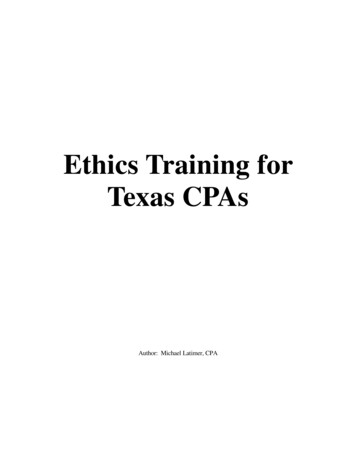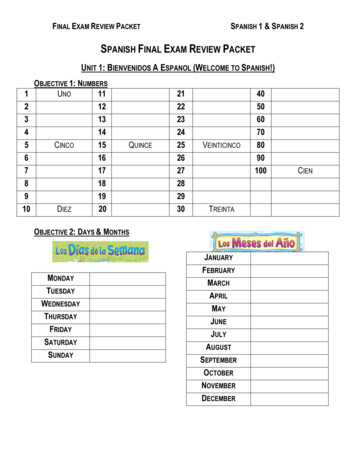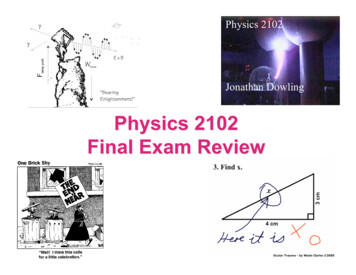
Transcription
Physics 2102Jonathan DowlingPhysics 2102Final Exam Review
A few concepts:electric force, field and potential Electric force:– What is the force on a charge produced by othercharges?– What is the force on a charge when immersed in anelectric field? Electric field:– What is the electric field produced by a system ofcharges? (Several point charges, or a continuousdistribution) Electric potential:– What is the potential produced by a system ofcharges? (Several point charges, or a continuousdistribution)
Plus a few other items Electric field lines, equipotential surfaces: lines go from ve to–ve charges; lines are perpendicular to equipotentials; lines(and equipotentials) never cross each other Gauss’ law: Φ q/ε0 . Given the field, what is the chargeenclosed? Given the charges, what is the flux? Use it todeduce formulas for electric field. Electric dipoles: field and potential produced BY a dipole,torque ON a dipole by an electric field, potential energy of adipole Electric potential, work and potential energy: work to bring acharge somewhere is W –qV (signs!). Potential energy of asystem negative work done to build it. Conductors: field and potential inside conductors, and on thesurface. Shell theorem: systems with spherical symmetry can bethought of as a single point charge (but how much charge?) Symmetry, and “infinite” systems.
Conductors and insulators Will two charged objects attractor repel? Can a charged object attract orrepel an uncharged object? What is the electric field inside aconductor? What is the direction of theelectric field on the surface of aconductor? What happens to a conductorwhen it is immersed in an electricfield?
Electric forces and fields: point chargesFigure 22N-14 shows an arrangement of four charged particles, with angle θ 34 and distance d 2.20 cm. The two negatively charged particles on the y axis areelectrons that are fixed in place; the particle at the right has a charge q2 5e(a) Find distance D such that the net force on theparticle at the left, due to the three other particles,is zero.(b) If the two electrons were moved further from thex axis, would the required value of D be greaterthan, less than, or the same as in part (a)?Other possible questions: what’s the electric field produced by the chargesXXX at point PPP ? what’s the electric potential produced by the charges XXXat point PPP ? What’s the potential energy of this system?
Electric dipoles What’s the electric field atthe center of the dipole?On axis? On the bisector?far away? What is the force on adipole in a uniform field? What is the torque on adipole in a uniform field? What is the potentialenergy of a dipole in auniform field?
Electric fields of distributed chargesPossible problems, questions: What’s the electric field at the centerof a charged circle? What’s the electric field at the centerof ¼ of a charged circle? What’s the electric field far from thering? far from the disk? What’s the electric field of aninfinite disk?
Gauss’ lawA long, non conducting, solid cylinder of radius 4.1 cm has a nonuniform volumecharge density that is a function of the radial distance r from the axis of thecylinder, as given by ρ Ar2, with A 2.3 µC/m5.(a) What is the magnitude of the electric field at a radial distance of 3.1 cm fromthe axis of the cylinder?(b) What is the magnitude of the electric field at a radial distance of 5.1 cm fromthe axis of the cylinder?
Gauss’ lawAt each point on the surface of the cube shown in Fig. 24-26, the electric field is inthe z direction. The length of each edge of the cube is 2.3 m. On the top surface ofthe cube E -38 k N/C, and on the bottom face of the cube E 11 k N/C.Determine the net charge contained within the cube.[-2.29e-09] C
Gauss’ law: applications
Electric potential, electric potentialenergy, workIn Fig. 25-39, point P is at the center of the rectangle. With V 0 at infinity, what isthe net electric potential in terms of q/d at P due to the six charged particles?
The figure shows conducting plates with area A 1m2, andthe potential on each plate. Assume you are far from theedges of the plates. What is the electric field between the plates in each case? What (and where) is the charge density on the plates incase (1)? What happens to an electron released midway betweenthe plates in case (1)?
Derive an expression in terms of q2/a for the work required to set up the fourcharge configuration of Fig. 25-50, assuming the charges are initially infinitely farapart.The electric potential at points in an xy plane is given by V (2.0 V/m2)x2 - (4.0V/m2)y2. What are the magnitude and direction of the electric field at point (3.0m, 3.0 m)?
Questions: from checkpoints andquestions in the textbook!U 5U0, 7U0, 3U0, 5U0
Problem Calculate electric field at point P.xPdxL Field very far away?aE
Potential of Continuous Charge Distribution Uniformly charged rodTotal charge QLength LWhat is V at position Pshown?xP! Q/Ldq ! dxLkdqk#dxV ! !r(L a"x)0L0 k" [! ln( L a ! x)]dxLa&L a#V k' ln !% a "
ProblemField at center of arc?
Line Of Charge: Field on bisectordEPDistanceCharge per unit lengthk (dq )dE 2dad!dxx oLq! Ld a2 x2Qk (! dx)adE y dE cos" 2(a x 2 )3 / 2acos! 22 1/ 2(a x )
Line Of Charge: Field on bisectorL/2L/2dx' xE y k# a !22 3 / 2 k( a % 222"(a x)& a x a # !L / 2"L / 2 2k!L22a 4a LWhat is E very far away from the line (L a)?Ey 2kλL/a(2a) kλL/a2 kq/a2What is E if the line is infinitely long (L a)?2k!L2k!Ey 2aa L
Problem: Gauss’ Law to Find E
Gauss’ Law: Cylindrical Symmetry Approximate as infinitely longline — E radiates outwards. Choose cylindrical surface ofradius R, length L co-axial withline of charge.E ?1m" E A E 2!RLq "L# !0 !0!L!! E 2k2"# 0 RL 2"# 0 RRR 1 mm
Potential Energy of aSystem of Charges
Potential Energy of A System of Charges 4 point charges (each Q) areconnected by strings, forming asquare of side L If all four strings suddenly snap,what is the kinetic energy ofeach charge when they are veryfar apart? Use conservation of energy:– Final kinetic energy of all fourcharges initial potential energystored energy required toassemble the system of charges Q Q Q QDo this from scratch!Don’t memorize theformula in the book!We will change thenumbers!!!
Potential Energy of A System ofCharges: Solution No energy needed to bring infirst charge: U1 0 Q Q Q Q Energy needed to bring2kQin 2nd charge: U QV 21L Energy needed to bringin 3rd charge kQ 2 kQ 2U 3 QV Q(V1 V2 ) L2L Energy needed to bringin 4th charge 2kQ 2 kQ 2U 4 QV Q(V1 V2 V3 ) L2LTotal potential energy is sum ofall the individual terms shownon left hand side kQ 2L(4 2 )So, final kinetic energy of each2charge kQ4L(4 2 )
Electric fields: ExampleCalculate the magnitude and direction ofthe electric field produced by a ring ofcharge Q and radius R, at a distance z onits axis.
Sample ProblemFigure 22N-14 shows an arrangement of four charged particles,with angle θ 34 and distance d 2.20 cm. The two negativelycharged particles on the y axis are electrons that are fixed inplace; the particle at the right has a charge q2 5e(a)Find distance D such that the netforce on the particle at the left, due tothe three other particles, is zero.(b) If the two electrons were movedfurther from the x axis, would therequired value of D be greater than,less than, or the same as in part (a)?
Exam 2 (Ch 26) Capacitors: capacitance and capacitors;caps in parallel and in series, dielectrics; energy, fieldand potential in capacitors. (Ch 27) Current and Resistance:Resistance current, currentdensity and drift velocity; resistance and resistivity;Ohm’s law. (Ch 28) Circuits: emf devices, loop and junctionrules; resistances in series and parallel; DC singleand multiloop circuits, power; RC circuits.
CapacitorsE σ/ε0 q/Aε0E Vdq CVC ε0A/dC κ ε0A/dC ε0ab/(b-a)
Current and resistancei dq/dtJunction ruleV iRE JρR ρL/Aρ ρ0(1 α(T T0))
DC CircuitsLoop ruleV iRP iVSingle loopMultiloop
Resistors and CapacitorsResistorsKey formula: V iRIn series:same currentReq RjIn parallel: same voltage1/Req 1/RjCapacitorsQ CVsame charge1/Ceq 1/Cjsame voltageCeq Cj
Capacitors and Resistorsin Series and in Parallel What’s the equivalent resistance (capacitance)? What’s the current (charge) in each resistor (capacitor)? What’s the potential across each resistor (capacitor)? What’s the current (charge) delivered by the battery?
RC CircuitsTime constant: RC(Charging: q (t ) CE 1 ! e ! t / RCDischarging: q (t ) q0 e ! t / RCi(t) dq/dt)
Capacitors: Checkpoints,Questions
Problem 25-21When switch S is thrown to the left, the plates of capacitor 1acquire a potential V0. Capacitors 2 and 3 are initiallyuncharged. The switch is now thrown to the right. What are thefinal charges q1, q2, and q3 on the capacitors?
Current and Resistance: Checkpoints,Questions
Problem 26-56A cylindrical resistor of radius 5.0mm andlength 2.0 cm is made of a material that hasa resistivity of 3.5x10-5 Ωm. What are the (a)current density and (b) the potentialdifference when the energy dissipation ratein the resistor is 1.0W?
Circuits: Checkpoints,Questions
1. HRW7 27.P.018. [406649]Figure 27-33 shows five 5.00 resistors.(Hint: For each pair of points, imagine that a battery is connectedacross the pair.)Fig. 27-33(a) Find the equivalent resistance between points F and H.(b) Find the equivalent resistance between points F and G.
5. HRW7 27.P.046. [406629]In an RC series circuit, E 17.0 V, R 1.50 MΩ, and C 1.80 µF.(a) Calculate the time constant.(b) Find the maximum charge that will appear on thecapacitor during charging.(c) How long does it take for the charge to build up to 10.0µC?
Magnetic Forces andTorquesvrrr rFF qv !B q Err rdF i dL ! Br r r" µ!BLr mvqB
Ch 28: Checkpoints andQuestions
5. HRW7 28.P.024. [566302]In the figure below, a charged particle moves into a region of uniformmagnetic field , goes through half a circle, and then exits that region. Theparticle is either a proton or an electron (you must decide which). Itspends 160 ns in the region.(a) What is the magnitude of B?(b) If the particle is sent back through the magnetic field (along the sameinitial path) but with 3.00 times its previous kinetic energy, how muchtime does it spend in the field during this trip?
Checkpoints/QuestionsMagnetic field?Force on each wire due tocurrents in the other wires?Magnitude of B·ds?
The current in wires A,B,D is out of thepage, current in C is into the page. Each wireproduces a circular field line going throughP, and the direction of the magnetic field foreach is given by the right hand rule. So, thecircles centers in A,B,D arecounterclockwise, the circle centered at C isclockwise. When you draw the arrows at thepoint P, the fields from B and C are pointingin the same direction (up and left).
A length of wire is formed into a closed circuit with radii a and b, asshown in the Figure, and carries a current i.(a) What are the magnitude and direction of B at point P?B µ 0 i"4!R(b) Find the magnetic dipole moment of the circuit.µ NiA
Induction and Inductance Faraday’s law:EMF " d! Bdtr rd! Bor C E # ds " dt Inductance: L NΦ/I– For a solenoid: L µ0n2Al µ0N2A/l Inductors: EL L di/dt RL circuits: i(t) (E/R)(1-e-tR/L) or i(t) i0e-tR/L Magnetic energy: U Li2/2; u B2/2µ0i
Checkpoints/QuestionsMagnitude/direction of induced current?Magnitude/direction of magnetic field inducing current?Magnitude of induced emf/current?Given E·ds , direction ofmagnetic field?Given B, dB/dt, magnitude ofelectric field?Current inducing EL?Largest L?Current through the battery?Time for current to rise 50% of max value?Largest current?R,L or2R,L orR, 2L or2R,2L?
When the switch is closed, theinductor begins to get charged,and the current isi (E/R)(1 e-tR/L).When the switch is opened, theinductors begins to discharge.The current inthis case is theni (E/R) e-t2R/L
Maxwell’s Equations:Gauss’! E dA q / "0Snameless! B dA 0SdB ds µ 0! 0 " E dA µ 0iAmpere"Maxwell’sdt SCDisplacement currentdFaraday’s E ds "B dA!C!dt S
Checkpoints/QuestionsGiven A, B at top and bottom, flux through curved sides?Rank integration paths according to B·dsB Magnetic field induced by E.Is E increasing or decreasing?Given a uniform E(t) in acircle, magnetic field at theedge?Discharging capacitor: direction ofdisplacement current, magnetic field?Charging capacitor: Which curve is for the B inthe wire, which for B in the capacitor gap?Map points: a,b,c,d into 1,2,3
A parallel-plate capacitor has square plates 1.0 m on a side as in Fig. 32-35. A current of 3.2 A charges the capacitor, producing a uniformelectric field E between the plates, with E perpendicular to the plates.(a)What is the displacement current through the region between the plates?(b) What is dE/dt in this region?(c) What is the displacement current through the square dashed path between the plates?(d) What is B · ds around this square dashed path?
Electric forces and fields: point charges Figure 22N-14 shows an arrangement of four charged particles, with angle θ 34 and distance d 2.20 cm. The two negatively charged particles on the y axis are electrons that are fixed in place; the particle at the right has a charge q 2 5e (a)Find distance D such that the net force on the particle at the left, due to the three other particles,
